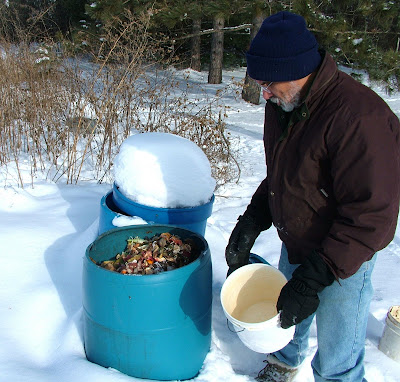Compost is integral to sustainable gardening practices. It is also a great way to get rid of kitchen waste without putting stuff into the trash stream. We’ve been composting for as long as we’ve been gardening and our system now is a pretty automatic routine.
All compostable kitchen waste is stored in a 2 1/2 gallon plastic bucket under the sink. Since we don’t eat any meat at home, most of our organic scrap waste goes into the compost bucket. That includes vegetable and fruit parings, coffee grounds, and leftover and spoiled foods that are not going to be eaten.
Dumping the raw waste directly onto the compost pile is not a good idea. Vermin are attracted to the decomposing food. It’s pretty unsightly and it sometimes stinks. We’ve developed a system that works quite well for disposing of the kitchen food waste.
I obtained some 55 gallon plastic food grade barrels at no cost from a local candy manufacturer. I cut off the tops of the drums and drilled about a dozen 1/4″ holes in the bottoms to allow for drainage. I dump the 2 1/2 gallon buckets of kitchen waste into the 55 gallon bucket. About 2 or 3 times a year, when the big drum gets full, I tip it over and layer the fragrant chunks, sometimes really stinky sludge, into a new compost pile.
Dumping the partially composted barrel into the bigger, drier pile really gets the pile cooking and eventually produces the very usable and good smelling material we know as compost, which is just about the most perfect fertilizer and soil amendment I know of. I have used animal manures in my garden occasionally over the years when it has become available, but now I don’t even seek it out. I don’t think manure is necessary for small scale growers.
When I tip over a 55 gallon drum of kitchen waste in the summer, it smells as rank as any manure pit. Our house in Minnesota was next to a dairy farm that milked 118 cows. I know what manure smells like. I’m coming pretty close to producing manure without passing it though an animal’s digestive system.
A thing I find very interesting about the compost in the barrels is that in summer, when the stuff is brewing and stinking up in the top half of the barrel, or even in the milder parts of the winter when the material in top of the barrel is frozen there is red worm activity going on in the bottom couple inches of the barrel. I never introduce these red worms. They just show up from the earth below the barrel and make their way through the 1/4″ holes to start feeding off the compost. I’ve emptied barrels and found the bottom couple inches of almost composted material thick with worms. Pretty cool!
In the summer, I clean out the 2 1/2 gallon kitchen bucket with dried plant residue or sometimes big burdock leaves. When the pail is really slimy or moldy I’ll wash it out using the garden hose and a brush. But I really like winters with lots of snow. Cleaning out the plastic bucket with snow is the least messy and easiest method of getting the bucket really clean without making a mess. The snow has an abrasive and absorptive quality that is ideal for loosening and holding the gunk. A little sloshing around and the pail is clean. I love a deep snow cover. It does my garden good. The past few years have seen very little December snow, but this year it is like the good old days. Lots and lots of white stuff. Our compost bucket is spiffy clean.

